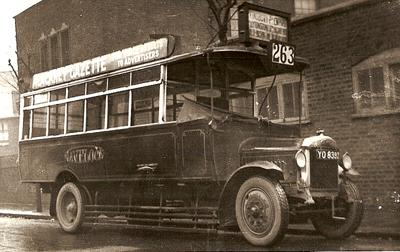The Havelock Arms
in Albion Drive, opposite Dalston Garage, from where Havelock
Motors started in the 1920s. RF467 passes on route 236
on 3 April 1971, the last month of RF operation. The pub sign
also appears
here.
Opposite Dalston Garage was The Havelock Arms pub. From
the yard at the back of the pub, one of the early independent
operators that challenged the London General Omnibus Company was
born - Havelock Motors Ltd.
The independents became known as "pirate" bus
companies because of the size and influence of the L.G.O.C.
Blacker, Lunn and Westgate in 'London Buses volume
one. The Independent Era' give details of Havelock Motors
Ltd. This began shortly after the First World War when
Charles Daiber and Frederick Ernest Mallindine purchased two buses
and entered into an arrangement with the licensee of the Havelock
public house, Louis Solomons. The arrangement was that Daiber
and Mallindine could garage their buses at the rear of Solomons'
premises, where they had a job-masters business (renting horses -
and perhaps motors?) entitled Havelock Motor Works.
The Havelock buses first appeared on London's
streets in December 1923 and operated routes 6A (Kensal
Rise to Hackney Wick) and 42A (Finsbury Park to
Camberwell Green), using two Dennis 4 ton buses with Dodson bodies
painted red (or crimson) and white. In 1925 the company was
expanded when Louis Solomon became majority shareholder. Five
additional buses - all Dodson-bodied Dennis 2½-ton,
painted chocolate and white - joined the fleet, three
starting work in June 1926 on new route 263 (Albion Road
to Leyton), which had been started two weeks earlier by ARO
Omnibus, and two more joining in December. He is also
recorded as having operated 3 AEC B-type coaches.

Havelock Motors' main route was the 263
(later
236). Dodson-bodied Dennis
2
½-ton YO8392 shows the destination Finsbury Park
Empire.
Photo David Ruddom
collection
The Reinohl collection at the LT Museum lists Havelock as
working at some time or other on the following routes:
9 Richmond - Liverpool
St, Sundays, 31 Dec 23 to 1 Dec 24
38B Victoria - Woodford
08/02/24, until 1 Dec 24
11 Shepherds Bush - Liverpool St,
from 1 Dec 24
138A Victoria - Woodford from 1 Dec
24
76 Victoria - Edmonton
Angel, 16 Feb 24
15A Ladbroke Grove - East Ham,
from 25 Mar 24
47A Shoreditch - Farnborough,
from 23 May 26
555 Leyton (Essex County Cricket Ground) -
Clapham Common, from July 1926
263 London Fields - Leyton Essex County
Cricket Ground, from July 1926 (sic),
extended Finsbury Park Empire - Leyton Essex
County Cricket Ground from 1 Jan 27 (sic).
Thanks to David Ruddom for the Reinold research, and the
photo. David notes that Reinohl was contemporary,
but suggests that some of these operations were short-lived
and perhaps exploratory.
Solomons sold the bus operation to London
Public Omnibus Co ('Public') in June 1927 (but continued
operations until the completion of negotiations in August) and
the lease for the garage to Empress Motors Ltd,
who used it as a workshop for their fleet of coaches (Empress
also operated buses, from their Canal Sidings garage, which came
into the LT fleet when the bus services were taken over in
1934). Solomons returned to his trade as a publican and
he employed Daiber as a manager in the Havelock.
The garage was destroyed by bombing during the
war and the site was built over by flats. The Havelock
Arms closed in 2002 and the site has been redeveloped with
more housing.
The East London & City Beer Guide
1983 produced by the East London & City branch of the Campaign
for Real Ale had this to say:
'Havelock Arms, 113 Albion Drive.
Whitbreads. Friendly side-street local
near housing estate. Hot & cold snacks am & pm/Live piano
singalong Fri-Sun eves.' By 1986 it read 'No handpumped
beers!'
London author Iain Sinclair recalls the Havelock in 'Hackney,
That Rose-Red Empire' (2009): "London Fields ... Going west, I
dodge through the stutter of evening traffic and into Shrubland
Road, at the point where it splits off into Albion Drive. A French
culture pundit, digital camera in hand, tracking across from the
nearest Underground station – which is not so near – was excited by
the faded sign hanging outside the doomed public house, the
Havelock. Plenty of Hackney old-timers, I discover as I conduct
interviews for this book, navigate their memory-terrain by way of
pubs. Do you remember? Being on firstname terms with the vampire
landlady? Crowblack fright wig, purple talons, heavy gold manacles
on thin wrist. Villainies of yesteryear: smoked ghosts propping up
afternoon bars, sentimental about dead gangsters, shoplifting
grannies. Holloway Nan. Shirley Pitts. Or revived literary
societies in back rooms? Politics, conspiracies, pool. The Havelock
is an anachronism. The coalfire fug, dirty glasses and recidivist
linoleum. These old brown boozers are London fictions in embryo,
waiting for the right ventriloquist: Patrick Hamilton, Derek
Raymond, T. S. Eliot. Listening is also writing. First the pubs,
then the petrol stations: they are declared redundant."
Little by little, London's history slips away.